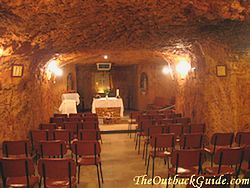This doesn’t look like Kansas anymore TOTO:
http://www.youtube.com/watch?v=F0-um0pHTAg
They have a cool organization to prove it:
http://www.greensburggreentown.org/
 Monday, April 20, 2009 at 10:08AM by
Monday, April 20, 2009 at 10:08AM by  Emily Schlickman
Emily Schlickman

Students survey the proposed site. Model of a new green housing design.
During the Fall of 2008 and Spring of 2009, graduate-level architecture students from the University of Colorado-Denver met with residents of Greensburg, Kansas to better understand the needs of the community and the devastation of the EF5 tornado that hit Greensburg almost 2 years ago. They spent the next 8 months researching the Kansas climate and the appropriate materials and building techniques for new “green” housing designs.
:}
 Saturday, April 18, 2009 at 10:22PM by
Saturday, April 18, 2009 at 10:22PM by  Catherine Hart
Catherine Hart

image courtesy of Local Burger
GreenTown will host supper Saturday, May 2 at 6:30 as part of the weekend of events observing the second anniversary of the tornado. (See entry from April 5, below, for itinerary.) Guests at our First Annual Green Initiative Awards banquet will be treated to a meal made possible by: Local Burger, a Lawrence, Kansas organic/sustainable/local foods eatery owned by Hilary Brown; Good Natured Family Farms, a consortium of over 100 family farms headed up by Diana Endicott; New Grass Bison Company, a sustainable food production and distribution company founded by Jeff Adair in 2001; and Anita Friesen, local Greensburg caterer extraordinaire.
:}
http://www.youtube.com/watch?v=KVCkD-SLmK0&feature=related
If you will remember 2 years ago they got wacked at the knees:
http://www.npr.org/templates/story/story.php?storyId=17643060
OH that’s Hendrick not Hendrix:
Kansas Town’s Green Dreams Could Save Its Future
by Frank Morris
All Things Considered, December 27, 2007 · Greensburg, a tiny town on the vast, flat prairie of western Kansas, is at the center of a grand experiment. In May, a tornado obliterated nearly every house, tree and business.
The twister — among the strongest on record — killed 10 people and displaced almost 1,400 residents. The community had been in steep decline before the storm, but city leaders quickly saw opportunity in the disaster. Perhaps they could revive Greensburg and sustain it for generations to come by making it the greenest town in America.
Rebuilding Better
Less than two days after the tornado, as huge machines began to tear into the wreckage of his hometown, School Superintendent Darren Hedrick managed to put a brave face on.
“Towns are about people, they’re not about buildings. And it’s a huge opportunity to rebuild — not just rebuild it the way it was but maybe rebuild it a little bit better than it was,” Hedrick said.
Though buildings, books and records were gone, Hedrick pledged to open school on time in the fall.
He did.
First-graders recently celebrated the end of an odd semester. Classes were held in small, white trailers lined up a quarter-mile from where most of the students now live. Their teacher, Laura Proser, says winter break marks a welcome milestone.
“We just got our stoplight yesterday, and everybody’s excited about that,” Proser said.
The Greening of Greensburg
Townhomes are beginning to rise from the ragged tree trunks, weeds and ruins off Main Street. They mark a radical departure from traditional low-income housing, according to Duncan Prahl, who is from Pennsylvania and on contract with the National Renewable Energy Labs.
:}
http://www.youtube.com/watch?v=-3Uia79MRrI&feature=related
Even Leonard DiCaprio got into the act:
http://www.inhabitat.com/2007/07/23/leonardo-di-caprio-to-build-eco-town-in-kansas/
by Tylene Levesque

Discovery’s new eco-lifestyle channel Planet Green is partnering with actor and avid environmentalist Leonardo DiCaprio to help launch the channel early next year with a touching environmentally-friendly project. DiCaprio is set to executive produce “Eco-Town,” a 13-part reality series which will follow state and local officials in their quest to build an ecologically—and economically—sustainable town in Kansas, aptly named Greensburg.
The series will document the green rebuilding of Greensburg, Kansas, a small town that was leveled by a devastating tornado on May 4th. Environmentally friendly, energy efficient materials and technology will be used to reconstruct the hundreds of homes and businesses damaged by the storm in hopes of encouraging many of the 1,500 residents to return home. We’re eagerly waiting to see what other green programs Planet Green has in store for us.
:}
http://www.youtube.com/watch?v=Z94RfLEzwAg&feature=related
But does it really take ALL of this to get earth friendly? Do we have to wait for disasters like Katrina to do the things we know are right. Isn’t this Environmentalism by suicide?
http://www.parade.com/news/2009/04/the-greenest-town-in-america.html
 1 of 3
1 of 3 
The Greenest Town in America
by Lamar Graham
published: 04/19/2009

1. The Greenest Town in America
2. Personality Parade
3. Wind Power
An eco-friendly home in Greensburg, Kansas. Photo by Jim Reed.
Darin Headrick, superintendent of schools in Greensburg, Kan., wasn’t particularly alarmed to hear a tornado siren wail on the evening of May 4, 2007. Such warnings are rites of spring in south-central Kansas, and when Mother Nature gets her dander up, “there’s nothing much you can do but get home, put the vehicles away, and get down in the basement,” Headrick says. So he and his wife went next door and joined their neighbors, a couple with two teenage daughters, in their below-ground rec room.
Violent wind, rain, and hail lashed the town. The power went out. Suddenly, Headrick says, “ there was a huge pressure change in the atmosphere.” They heard glass begin to shatter above them, then a sound like a giant wrecking ball.
Miraculously, the planks over their heads held fast. The rest of the house simply vanished. So did every other dwelling in the vicinity. For a desperate hour, the two families searched for neighbors. Eventually, they set out on foot for the dark center of town.
Every house and building they passed had been flattened. “We met people coming from the other direction,” Headrick recalls. “They said, ‘It’s not any better back there.’ That’s when we knew.” Greensburg, population 1574, had been wiped off the map.
 Devastated but not destroyed: Greensburg after the twister that killed 11 on May 4, 2007 Devastated but not destroyed: Greensburg after the twister that killed 11 on May 4, 2007
|
The tornado that obliterated Greensburg was one of the strongest ever recorded anywhere, with winds of 205 mph and a footprint 1.7 miles wide. The town, only about 1.5 square miles, never stood a chance. Eleven people died. Fewer than a dozen homes were left standing.
The devastation was so complete that folks in Greensburg wondered whether to rebuild at all. Even before the twister, their town had been on the wane, its population graying, its young people moving away. “Rural America is kind of dying,” Headrick observes.
:}









 Monday, April 20, 2009 at 10:08AM
Monday, April 20, 2009 at 10:08AM









